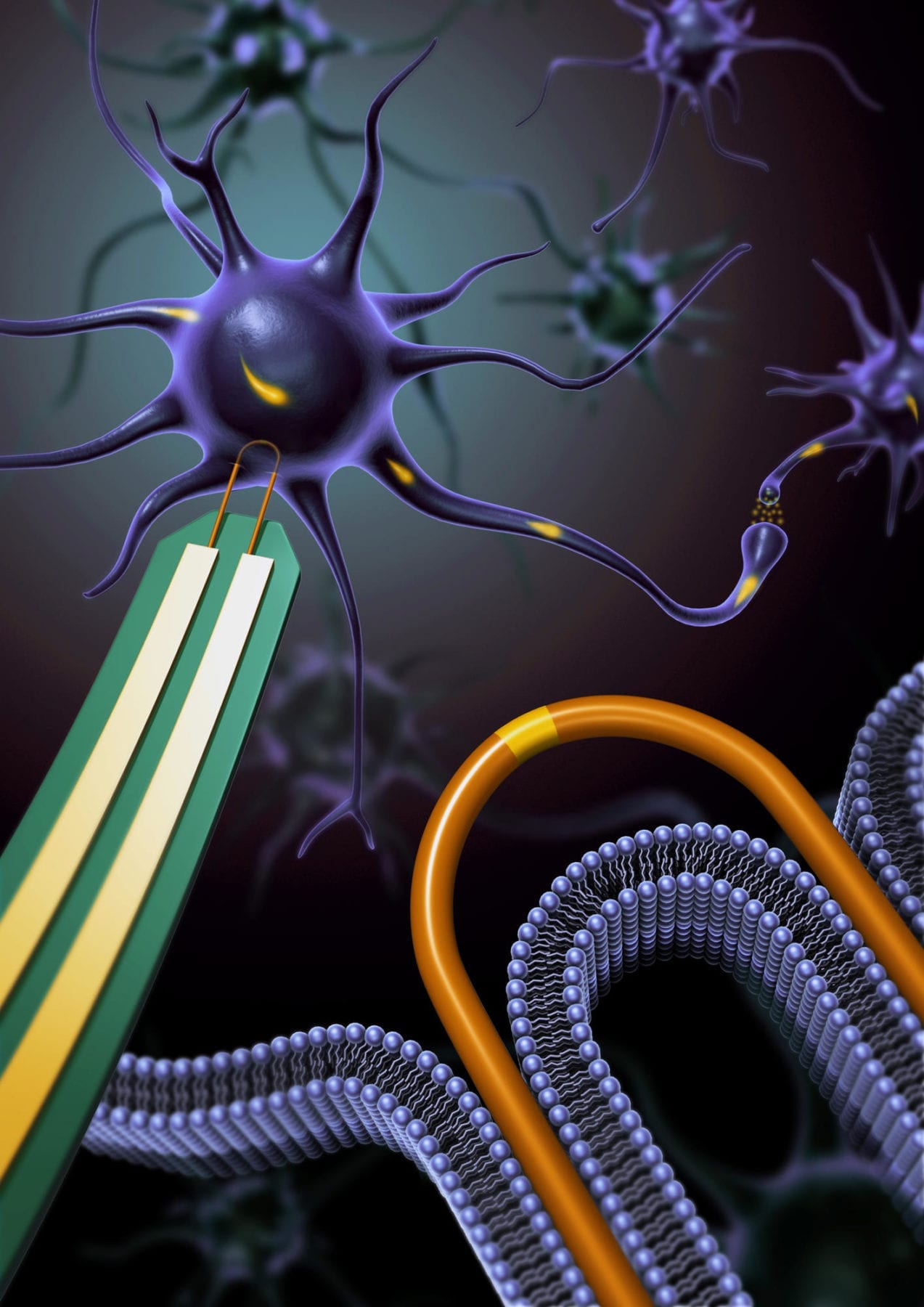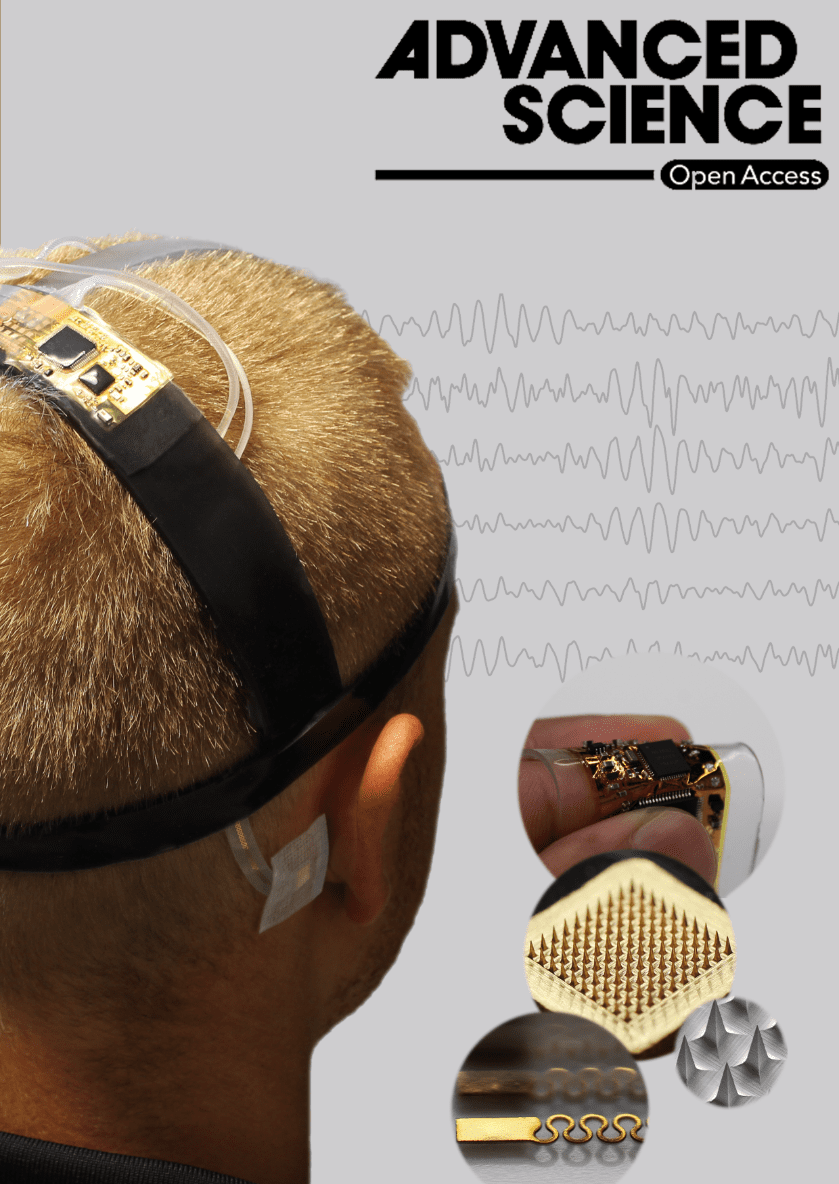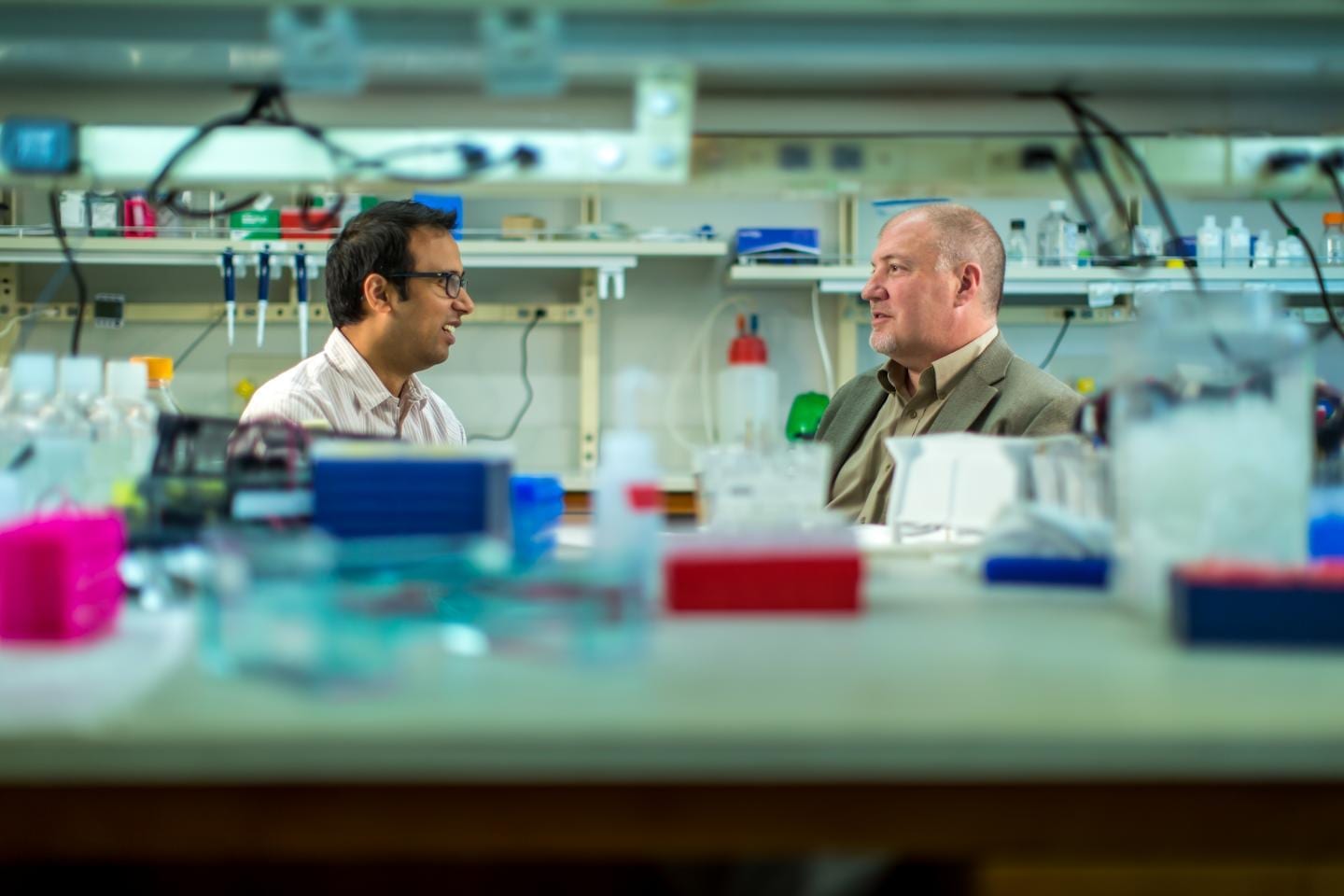
Combing out a tangled problem
Machines are getting cozy with our cells. Embeddable sensors record how and when neurons fire; electrodes spark heart cells to beat or brain cells to fire; neuron-like devices could even encourage faster regrowth after implantation in the brain.
Soon, so-called brain-machine interfaces could do even more: monitor and treat symptoms of neurological disorders like Parkinson’s disease, provide a blueprint to design artificial intelligence, or even enable brain-to-brain communication.
To achieve the reachable and quixotic, devices need a way to literally dive deeper into our cells to perform reconnaissance. The more we know about how neurons work, the more we can emulate, replicate, and treat them with our machines.
Now, in a paper published in Nature Nanotechnology, Charles M. Lieber, the Joshua and Beth Friedman University Professor, presents an update to his original nanoscale devices for intracellular recording, the first nanotechnology developed to record electrical chatter inside a live cell. Nine years later, Lieber and his team have designed a way to make thousands of these devices at once, creating a nanoscale army that could speed efforts to find out what’s happening inside our cells.
Prior to Lieber’s work, similar devices faced a Goldilocks conundrum: Too big, and they would record internal signals but kill the cell. Too small, and they failed to cross the cell’s membrane — recordings ended up noisy and imprecise.
Lieber’s new nanowires were just right. Designed in 2010, the originals had a nanoscale V-shaped tip with a transistor at the bottom of the V. This design could pierce cell membranes and send accurate data back without destroying the cell.
But there was a problem. Silicon nanowires are far longer than they are wide, making them wobbly and hard to wrangle. “They’re as flexible as cooked noodles,” said Anqi Zhang, a Ph.D. student in the Department of Chemistry in the Graduate School of Arts and Sciences and a member of the Lieber Lab. Zhang is a co-author on the team’s latest work.
To create the original devices, lab members had to ensnare one nanowire noodle at a time, find each arm of the V, and then weave the wires into the recording device. Two devices took two to three weeks to make. “It was very tedious work,” said Zhang.
But nanowires are not made one at a time; they’re made en masse like the thing they resemble: cooked spaghetti. Using the nanocluster catalyzed vapor-liquid-solid method, with which Lieber created the first nanowires, the team built an environment where the wires could germinate on their own. They can pre-determine each wire’s diameter and length but not how the wires are positioned once ready. Even though they grow thousands or even millions of nanowires at a time, the end result is a tangled mess.
So, Lieber and his team designed a trap for their loose cooked noodles: They make U-shaped trenches on a silicon wafer and then comb the nanowires across the surface. This “combing” process untangles the mess and deposits each nanowire into a neat U-shaped hole. Then, each “U” curve gets a tiny transistor, similar to the bottom of their “V” shaped devices.
With the “combing” method, Lieber and his team complete hundreds of nanowire devices in the same amount of time they used to make just a couple. “Because they’re very well-aligned, they’re very easy to control,” Zhang says.
So far, Zhang and her colleagues have used the “U” shaped nanoscale devices to record intracellular signals in both neural and cardiac cells in cultures. Coated with a substance that mimics the feel of a cell membrane, the nanowires can cross this barrier with minimal effort or damage to the cell. And, they can record intracellular chatter with the same level of precision as their biggest competitor: patch clamp electrodes.
Patch clamp electrodes are about 100 times bigger than nanowires. As the name suggests, the tool clamps down on a cell’s membrane, causing irreversible damage. The patch clamp electrode can capture stable recording of the electrical signals inside the cells. But, Zhang says, “after recording, the cell dies.”
The Lieber team’s U-shaped nanoscale devices are friendlier to their cell hosts. “They can be inserted into multiple cells in parallel without causing damage,” Zhang said.
Right now, the devices are so gentle that the cell membrane nudges them out after about 10 minutes of recording. To extend this window with their next design, the team is considering adding a bit of biochemical glue to the tip or roughing up the edges so the wire catches against the membrane.
The nanoscale devices have another advantage over the patch clamp: They can record more cells in parallel. With the clamps, researchers can collect just a few cell recordings at a time. For this study, Zhang recorded up to 10 cells at once. “Potentially, that can be much greater,” she says. The more cells they can record at a time, the more they can see how networks of cells interact with each other as they do in living creatures.
In the process of scaling their nanowire design, the team also confirmed a long-standing theory called the curvature hypothesis. After Lieber invented the first nanowires, researchers speculated that the width of a nanowire’s tip (the bottom of the V or U) can affect a cell’s response to the wire. For this study, the team experimented with multiple U curves and transistor sizes. The results confirmed the original hypothesis: Cells like a narrow tip and a small transistor.
“The beauty of science to many, ourselves included, is having such challenges to drive hypotheses and future work,” Lieber said. With the scalability challenge behind them, the team hopes to capture even more precise recordings, perhaps within subcellular structures, and record cells in living creatures.
But for Lieber, one brain-machine challenge is more enticing than all others: “bringing cyborgs to reality.”
Learn more: Combing out a tangled problem
The Latest on: Nanoscale devices for intracellular recording
[google_news title=”” keyword=”nanoscale devices for intracellular recording” num_posts=”10″ blurb_length=”0″ show_thumb=”left”]
via Google News
The Latest on: Nanoscale devices for intracellular recording
- Nanocapacitors: Storing Electrical Energy in Nanoscale Deviceson April 30, 2024 at 8:03 am
Nanoscale capacitors, such as supercapacitors and micro-supercapacitors, are promising energy storage solutions for portable electronics, wearable devices, and autonomous sensors. They offer high ...
- A molecular moon lander: Insight into molecular motion on surfaces at the nanoscaleon April 10, 2024 at 5:00 pm
The process is critical to numerous applications, including catalysis and the manufacturing of nanoscale devices. The work is published in the journal Communications Chemistry. In fact ...
- Micro-Lisa: Making a mark with novel nano-scale laser writingon March 26, 2024 at 11:43 am
High-power lasers are often used to modify polymer surfaces to make high-tech biomedical products, electronics and data storage components. Now Flinders University researchers have discovered a ...
- Theoretical Foundations of Nanoscale Quantum Deviceson March 12, 2024 at 9:08 am
Nanooptics which describes the interaction of light with matter at the nanoscale, is a topic of great fundamental ... your Personal Document Settings on the Manage Your Content and Devices page of ...
- Jong Hanon December 23, 2023 at 3:03 pm
With today’s advancement in nanotechnology, the external electric bias applied on nanoscale devices opens up new realm of physics questions which had been non-questions a few decades ago. The examples ...
- Theoretical Foundations of Nanoscale Quantum Deviceson August 6, 2023 at 7:50 am
Nanooptics which describes the interaction of light with matter at the nanoscale, is a topic of great fundamental interest to physicists and engineers and allows the direct observation of quantum ...
- Nanoscale Horizons Outstanding Paper Awardon April 26, 2023 at 3:12 pm
In order to recognize some of the outstanding work published in the journal, as well as the authors behind those articles, we annually award a Nanoscale Horizons Outstanding Paper Award. The prizes ...
- Jeongwon Parkon December 2, 2021 at 3:20 pm
The figure shows challenges of the future nanowire-based devices that I am interested in investigating, which describes the challenges of the gate all around the structure with nanowires transistor ...
- Nanowire photonicson November 30, 2021 at 12:28 pm
This has led to a host of nanowire photonic devices including photodetectors ... owing to issues such as the difficulty of fabricating reliable nanoscale metal–semiconductor contacts.
- Research Focuson August 16, 2020 at 8:44 pm
Other goals include improving the performance and reliability of existing devices, as well as designing new systems around them. Solid-state electronics research spans electromagnetic wave ...
via Bing News











